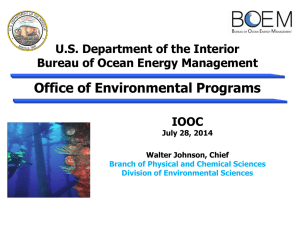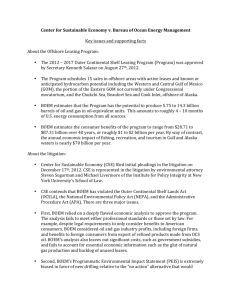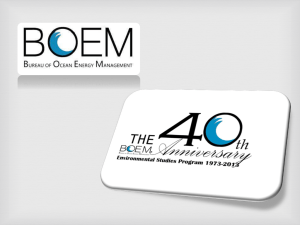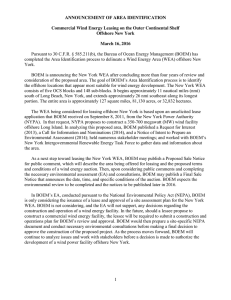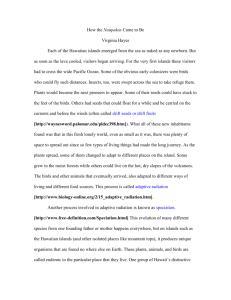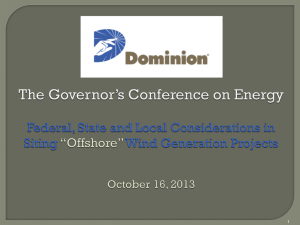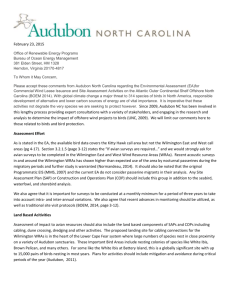Ball, 2015 - Honua Consulting
advertisement
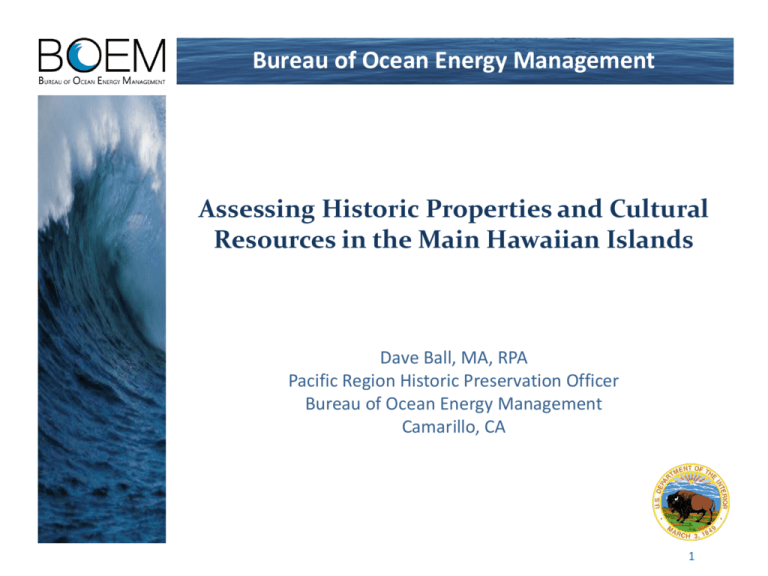
Bureau of Ocean Energy Management Assessing Historic Properties and Cultural Resources in the Main Hawaiian Islands Dave Ball, MA, RPA Pacific Region Historic Preservation Officer Bureau of Ocean Energy Management Camarillo, CA 1 Bureau of Ocean Energy Management • • • Bureau within the U.S. Department of the Interior Manages the nation’s energy and marine mineral resources on the OCS Regions: Alaska, Pacific, Gulf of Mexico, Atlantic (Office of Renewable Energy) Hawai’i OCS 2 BOEM: Environmental Studies Program Mission: To provide the information needed to predict, assess and manage impacts from offshore energy and marine mineral exploration, development and production activities on human, marine and coastal environments. The Environmental Studies Program (ESP) was initiated in 1973 to support the U.S. Department of the Interior's offshore oil and gas leasing program. General goals for the ESP program include: • Establish the information needed for assessment and management of environmental impacts on the human, marine and coastal environments of the Outer Continental Shelf (OCS) and the potentially affected coastal areas; • Predict impacts on the marine biota which may result from chronic, low-level pollution or large spills associated with OCS production, from drilling fluids and cuttings discharges, pipeline emplacement or onshore facilities; • Monitor human, marine and coastal environments to provide time series and data trend information for identification of significant changes in the quality and productivity of these environments and to identify the causes of these changes. 3 BOEM Funded Research in Hawaii • Habitat Affinities and At‐Sea Ranging Behaviors Among Main Hawaiian Island Seabirds • Pacific Regional Ocean Uses Atlas • A Marine Biogeographic Assessment of the Main Hawaiian Islands • Maritime Cultural Resources Site Assessment in the Main Hawaiian Islands 4 BOEM Funded Research Habitat Affinities and At‐Sea Ranging Behaviors Among Main Hawaiian Island Seabirds Objectives: Conduct field studies of at‐sea habitat utilization and ranging behaviors for seabirds breeding within the Main Hawaiian islands; Compile and analyze remotely sensed and modeled habitat data to examine habitat relationships to predict species’ distributions and improve spatial vulnerability maps. Partnership: BOEM, USGS 5 BOEM Funded Research in Hawaii Pacific Regional Ocean Uses Atlas Military Use Objectives: Document patterns of existing and emerging ocean uses throughout the Main Hawaiian Islands through participatory mapping workshops; Renewable Energy Fishing Uses Non-Consumptive Uses Industrial Uses Identify potential areas of conflict and/or compatibility between proposed renewable energy areas and other ocean uses Study Area Partnership: BOEM, NOAA, State of Hawaii Office of Planning State waters Federal waters BOEM Funded Research in Hawaii A Marine Biogeographic Assessment of the Main Hawaiian Islands Objectives: Characterize the distributions of living marine resources and their habitats found offshore of the Main Hawaiian Islands; Identify living marine resource data gaps; Support the development of spatial tools for planning and review of offshore renewable energy proposals in Hawaii. Partnership: BOEM, NOAA National Center for Coastal Ocean Science 7 BOEM Funded Research Maritime Cultural Resources Site Assessment in the Main Hawaiian Islands Purpose: To better understand the types and locations of significant archaeological and cultural resources that require consideration during the planning process for offshore renewable energy development. Goal: Develop a database of underwater and land-based cultural resources that could be affected by construction of offshore renewable energy facilities and develop a proactive approach to working with Native Hawaiian communities that integrates science with historical, archaeological, and traditional knowledge to identify areas of significance that need to be considered in the federal planning process. Study Area Geography: The eight main Hawaiian Islands. Partnership: BOEM, NOAA State waters Federal waters 8 BOEM Funded Research Characterizing Tribal Cultural Landscapes Purpose: To better understand the types and locations of significant archaeological and cultural resources that require consideration during the planning process for offshore renewable energy development. Goal: Develop a proactive approach to working with Native American communities that integrates science with historical, archaeological, and traditional knowledge to identify areas of tribal significance that need to be considered in the federal planning process. Geography: Coastal and offshore California, Oregon, and Washington. Partnership: BOEM, NOAA, in partnership with the Confederated Tribes of Grand Ronde, Makah Tribe, and Yurok Tribe. 9 Cultural Landscape Approach At its most basic: Understanding that humans are part of the landscape, shaping & being shaped by it; Intimate knowledge of place; Over time; Using that knowledge to inform planning & future management. 10 Cultural Landscape Approach Takes into account: Cultural heritage & resources as part of the ecosystem & part of the broader landscape; Examines relationships among all resources of the place and their environment over time. In order to: Integrate management of cultural and natural resources at the ecosystem and landscape level--similar to ecosystem-based management. 11 TCL Purpose and Goals • Increase preservation & consideration of places & cultural resources significant to tribes; • Enhance ocean planning for energy development; • Develop a proactive approach to working with tribes; • Facilitate decisionmaking processes appropriate to each locale. 12 TCL Approach • Holistic approach that integrates science with archaeological, historical, & traditional knowledge. • Transferable method for any coastal tribe to document significant places and cultural resources. • Enhanced capability for consultation. 13 TCL Activities • Intertribal workshops to develop common terminology. • Guidance Document documenting process & methodology. • Case studies demonstrating methodology as developed by each tribe. • Outreach -- not including sensitive data. 14 TCL Activities: Definition Tribal Cultural Landscape: Any place in which a relationship, past or present, exists between a spatial area, resource, and an associated group of indigenous people whose cultural practices, beliefs, or identity connects them to that place. A tribal cultural landscape is determined by and known to a culturally related group of indigenous people with relationships to that place. 15 TCL Case Studies Cultural resources identified include: • traditional cultural properties; • traditional subsistence & commerce activities; • residential & occupational activities; • spiritual & ceremonial sites and activities. Methods include: • archival research; • field investigations and site visits; • community outreach; • oral histories. 16 Pacific OCS Region Contact Dave Ball Pacific Region Historic Preservation Officer Bureau of Ocean Energy Management 805-384-6340 David.Ball@BOEM.gov www.BOEM.gov 17

